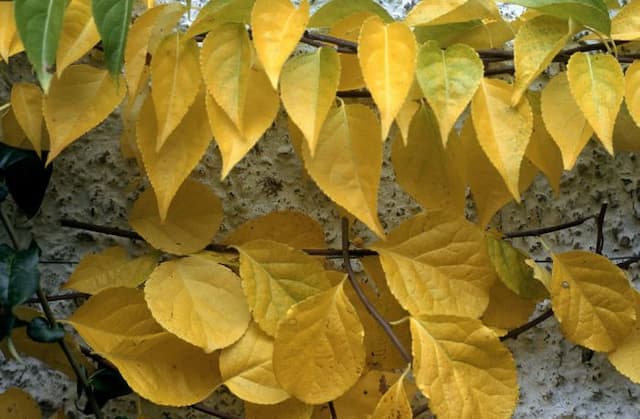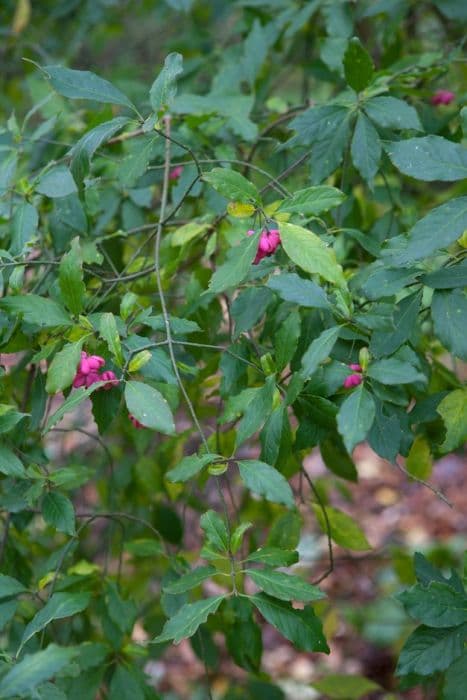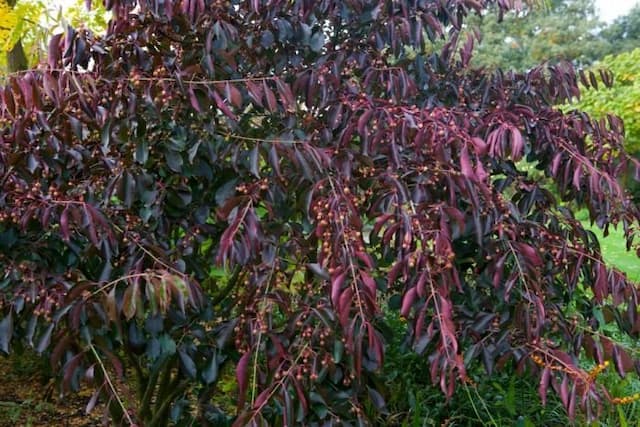Japanese Spindle Euonymus japonicus 'Green Rocket'

ABOUT
The 'Green Rocket' is a variety of a plant commonly known as Japanese spindle. It displays a dense, upright and columnar growth habit, making it a favored choice for architectural garden designs or as a privacy screen. The plant flaunts a rich collection of glossy, dark green leaves that maintain their vibrant color throughout the seasons. The leaves are oval-shaped with finely serrated edges and are arranged neatly, opposite each other along the stems, contributing to the plant's tidy and well-groomed appearance. During the late spring or early summer, the Japanese spindle 'Green Rocket' presents inconspicuous greenish-white flowers. Although these blooms are not particularly showy, they can add a subtle charm to the plant's overall presentation. Following the flowering period, it might bear small, pink to reddish-purple fruits, which are attractive to birds but considered inedible for humans. This plant's ability to withstand a range of growing conditions, along with its elegant and resilient foliage, makes it an ideal choice for hedges, formal garden spaces or as a standalone specimen in a landscape. Its well-defined shape and evergreen nature ensure that it provides year-round interest without the necessity of frequent maintenance or complex care requirements.
About this plant
 Names
NamesSynonyms
Japanese Spindle, Evergreen Spindle, Green Rocket.
Common names
Euonymus japonicus 'Green Rocket'.
 Toxicity
ToxicityTo humans
Japanese spindle is considered toxic when ingested. All parts of the plant contain alkaloids and other compounds which can cause a variety of symptoms if eaten. The severity of the symptoms can vary depending on the amount ingested. Possible symptoms of poisoning include nausea, vomiting, abdominal pain, diarrhea, and weakness. In some cases, ingestion can lead to more severe symptoms such as chills, convulsions, or changes in heart rhythm. It is important to seek medical attention if ingestion is suspected.
To pets
Japanese spindle is also toxic to pets, including dogs and cats. The toxic principles are similar to those affecting humans, and pets that ingest any part of the plant may experience symptoms such as vomiting, diarrhea, abdominal pain, weakness, and in severe cases, potential heart problems or seizures. It is important to keep this plant out of reach of pets and to consult a veterinarian immediately if you suspect your pet has ingested any part of it.
 Characteristics
CharacteristicsLife cycle
Perennials
Foliage type
Evergreen
Color of leaves
Green
Height
2-3 feet (0.6-0.9 meters)
Spread
1-2 feet (0.3-0.6 meters)
Plant type
Shrub
Hardiness zones
6-9
Native area
Japan
Benefits
 General Benefits
General Benefits- Low Maintenance: The 'Green Rocket' is known for being easy to care for, requiring minimal upkeep beyond occasional pruning.
- Drought Tolerance: Once established, it can withstand periods of low water availability, making it suitable for various climates.
- Fast Growing: Provides quick coverage or fills in garden spaces rapidly due to its growth rate.
- Evergreen Foliage: Maintains its vibrant green leaves throughout the year, ensuring constant garden interest.
- Adaptable: Can thrive in a range of soil types and conditions, from acidic to alkaline.
- Dense Growth Habit: Its compact and dense foliage is ideal for privacy screens or hedges.
- Pest Resistant: Generally resists common garden pests, reducing the need for chemical treatments.
- Versatile Landscaping: Suitable for a variety of design uses, including formal gardens, foundation plantings, and containers.
 Medical Properties
Medical PropertiesThis plant is not used for medical purposes.
 Air-purifying Qualities
Air-purifying QualitiesThis plant is not specifically known for air purifying qualities.
 Other Uses
Other Uses- Privacy Screening: Euonymus japonicus 'Green Rocket' can be used as a natural privacy screen due to its dense growth habit, providing a green barrier between properties.
- Topiary Art: With its ability to tolerate heavy pruning, this plant can be sculpted into various shapes for decorative purposes in gardens and landscapes.
- Insect Repellent: The foliage of Green Rocket may deter certain insects due to its texture and potential natural repellent properties, making it a practical choice in pest-prone areas.
- Sound Barrier: Dense hedging with Green Rocket can help reduce noise pollution when planted along roadsides or between different areas of a garden.
- Dye Production: The berries of Green Rocket can be used to produce dyes for textiles, though this is not a typical use.
- Educational Tool: This versatile plant can be used in educational settings, such as schools or botanical gardens, to teach about plant growth, maintenance, and landscape design.
- Festive Decorations: Twigs and branches of Green Rocket can be trimmed and used as greenery in festive wreaths and holiday arrangements.
- Landscape Sculpting: Green Rocket can be used to create natural sculptures within a garden, adding aesthetic appeal and serving as focal points or garden highlights.
- Windbreaks: Larger specimens can function as windbreaks in coastal or windy regions, protecting smaller plants and reducing wind erosion.
- Wildlife Shelter: Thick hedges of Green Rocket provide shelter and potential nesting sites for birds and other small wildlife.
Interesting Facts
 Feng Shui
Feng ShuiThe Japanese Spindle is not used in Feng Shui practice.
 Zodiac Sign Compitability
Zodiac Sign CompitabilityThe Japanese Spindle is not used in astrology practice.
 Plant Symbolism
Plant Symbolism- Endurance: Euonymus japonicus, commonly known as Japanese Spindle, is known for its hardy nature and ability to survive in various conditions, making it a symbol of endurance and persistence.
- Protection: The dense foliage of the Japanese Spindle has been thought to act as a barrier, representing protection and safety.
- Good Fortune: In some cultures, the bright berries of some Euonymus species are considered symbols of good fortune and prosperity.
- Adaptability: The adaptability of this plant to different soils and light conditions symbolizes flexibility and the ability to thrive in diverse environments.
 Water
WaterThe Japanese Spindle 'Green Rocket' prefers even moisture, so water the plant when the top inch of soil feels dry to the touch. Typically, this means watering every 7 to 10 days, but it will vary depending on climate and soil drainage. Use a slow and deep watering method to encourage root growth, providing about 1 to 1.5 gallons of water per week during the growing season. Reduce watering in the winter months when the plant's growth slows down.
 Light
LightThe Japanese Spindle 'Green Rocket' grows best in full sun to partial shade. Choose a location where the plant will receive at least 4 to 6 hours of sunlight per day. Some dappled afternoon shade can be beneficial in extremely hot climates to prevent leaf scorch.
 Temperature
TemperatureThe Japanese Spindle 'Green Rocket' can tolerate a wide range of temperatures, but it prefers a temperate climate. It can generally survive winter temperatures as low as 5 degrees Fahrenheit and summer temperatures up to 95 degrees Fahrenheit. Ideal growing conditions are between 50 and 80 degrees Fahrenheit.
 Pruning
PruningPrune the Japanese Spindle 'Green Rocket' to maintain its shape and encourage bushy growth. The best time to prune is in late winter or early spring before new growth begins. Prune lightly, removing any dead or damaged branches, and shape as desired. Pruning can be done annually or as needed to control size.
 Cleaning
CleaningAs needed
 Soil
SoilJapanese Spindle 'Green Rocket' thrives in well-draining, fertile soil with a slightly acidic to slightly alkaline pH range of 6.0 to 7.5. The ideal soil mix can be created by blending garden soil with peat, compost, and a small amount of sand to ensure good aeration and drainage.
 Repotting
RepottingJapanese Spindle 'Green Rocket' should be repotted every 2 to 3 years to refresh the soil and accommodate the growing root system. Repotting is usually done in the spring or early summer, just before a period of active growth.
 Humidity & Misting
Humidity & MistingJapanese Spindle 'Green Rocket' can adapt to a wide range of humidity conditions and typically does well in the average humidity found in most homes. Humidity levels around 40-60% are adequate for this plant.
 Suitable locations
Suitable locationsIndoor
Give bright indirect light, water when topsoil is dry.
Outdoor
Plant in well-drained soil, partial to full sun.
Hardiness zone
6-9 USDA
 Life cycle
Life cycleThe Japanese spindle 'Green Rocket', starts its life cycle as a seed that, once germinated, develops into a small seedling with its first true leaves. As it enters the vegetative growth phase, the seedling matures into a bushy shrub, with dense, dark green foliage. When environmental conditions are favorable, typically in late spring or early summer, it blooms with small, inconspicuous greenish-white flowers. Following the flowering stage, the plant produces pinkish-red fruit that matures to a more subdued color, and contains seeds for the next generation. In the maturity stage, the shrub can be maintained by pruning to keep its size and shape, and it can live for many years if undisturbed by external stressors. During the dormant season, usually in winter, growth slows down and the plant conserves energy, waiting for the warmer weather of spring to resume active growth.
 Propogation
PropogationPropogation time
Spring-Early Summer
The most popular method to propagate Japanese Spindle 'Green Rocket' is through semi-hardwood cuttings. This technique is generally performed during the late summer months. To propagate, a gardener should select a healthy branch and cut a 4 to 6-inch (10 to 15 cm) length that includes several leaf nodes. The lower leaves are removed and the cut end is often dipped in rooting hormone to encourage root development. This cutting is then inserted into a well-draining soil mix and kept moist but not waterlogged until roots have established, which may take several weeks. The new plants should be kept in a protected environment with indirect light until they are strong enough to transplant outdoors.







